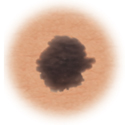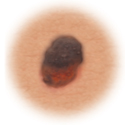Content
Melanoma: Symptoms
What are the symptoms of melanoma?
The first symptom of melanoma is often a change in a mole, or the appearance of a new mole. These ABCDE rule can help you tell a normal mole from one that might be melanoma. The ABCDE rule is:
Asymmetry. One half of the mole does not match the other half.
Border irregularity. The edges of the mole are ragged or irregular.
Color. The mole has different colors in it. It may be tan, brown, black, red, or other colors. Or it may have areas that seem to have lost color.
Diameter. The mole is bigger than 6 millimeters across, about the size of a pencil eraser. But some melanomas can be smaller.
Evolving. A mole changes in size, shape, or color.
Melanoma | Sign | Characteristic |
Asymmetry | When half of the mole does not match the other half | |
Border | When the borders (edges) of the mole are ragged or irregular | |
Color | When the color of the mole varies throughout | |
Diameter | If the mole's diameter is larger than a pencil's eraser | |
Evolving | Changes in the way the mole looks over time |
Other signs and symptoms that may be melanoma include:
A mole that itches or is sore.
A mole that oozes, bleeds, or becomes crusty.
A mole that looks different from your other moles.
A sore that doesn't heal.
A mole or sore becomes red or swells at its edges or beyond.
Get to know your moles
Become familiar with the way your moles look so you will know if they’re changing. Take note of any new moles that appear on your skin.
When to see your healthcare provider
Most moles are not melanomas. But it is important to see your healthcare provider if you have moles or other spots on your skin with the features above. Also see your provider if you are worried about a spot on your skin for some other reason. Your healthcare provider will examine the mole and do testing on it to find out if you have cancer.







